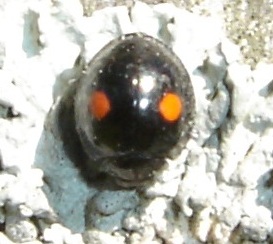Black Ladybug
When you think of the ladybug you usually think of the solid red bug with black dots, however, it has a cousin that is quite the opposite in color. Well actually, a few cousins (with different designs), that are black ladybugs. They have a solid black shield like shell for protection with red dots on it, along with other designs. Almost like the evil twin you see in the media, this ladybug has many twins (or cousins I should say).
Well anyways, we have complied a list here and will continually work on these list as we find more data on each of these categories. We also give credit to the photographer for taking the main picture you see for this article: Parihav at English Wikimedia.
Chilocorus stigma or AKA Twice-stabbed Lady Beetle

Taxonomy: Beetles (Coleoptera) »Water, Rove, Scarab, Long-horned, Leaf and Snout Beetles (Polyphaga) » Series Cucujiformia » Coccinelloidea »Coccinellid group » Lady Beetles (Coccinellidae) » Chilocorinae » Twice-stabbed Lady Beetles (Chilocorus) » Twice-stabbed Lady Beetle (Chilocorus stigma)
Physical Description of This Black Ladybug
It has a black shell around body to help protect it with two big red dots on both sides of it’s elytra. Seems like that’s where the name come from, with Twice-stabbed Lady Beetle being the name, due to the two big dots on it’s shell. The head is also black and blends in with the rest of it’s shell. The body on the inside is brown and you can see this when it opens up it’s shell to fly.
Size & Location
It’s size is around 4-6mm and very comparable in size to the normal ladybug. It’s native of the United States but not as much in the western part of the country such as the mountain range in Nevada. You can also find this beetle in Canada also as it spreads farther north. They live among the trees and plantation to find the majority if their food.
Prey & Predators
They feed on small plant lice known as whiteflies and find these among plantation. This is a great because these lice have become pest to the farmers and destroying plants all over the world. They also eat mealybugs that are also considered pest to the farmer that eat within greenhouses where it’s more warm and moist. This black ladybug makes a great pest control for the farmer, but due to numbers, they’re not sold for this reason.
Is this Black Ladybug Harmful to Humans?
No, because they have no ability to hurt us in anyway. They can be annoying when they congregate within a vehicle, however, these ladybugs are not harmful in anyway. They don’t spread diseases, they’re not parasites, and they don’t take over homes while making everything unsanitary. They’re completely harmless and they simply help us instead with controlling pest within the agricultural world.

Source: F.C. Schweissing, Bugwood.org
Another Black Ladybug AKA Spider Mite Destroyer
Taxonomy: Beetles (Coleoptera) »Water, Rove, Scarab, Long-horned, Leaf and Snout Beetles (Polyphaga) » Series Cucujiformia » Coccinelloidea »Coccinellid group » Lady Beetles (Coccinellidae) » Scymninae » Stethorus » Spider Mite Destroyer (Stethorus punctum)
Known as the Spider Mite Destroyer, another black ladybug, this bug is another friend of the farmer as he fights off pest that can destroy plants. Much similar to the Twice-stabbed Lady Beetle, it fights for many kinds of plants.
Physical Description & Location of the Black Ladybug
This beetle is solid black with yellow legs. The shell is shiny and does not have any design on it’s shell whatsoever. However in size they’re much smaller than the other cousins. In size, the adults are within the 1-2mm range. If you get close enough, you can see the hairs that come through it’s body. The Spider Mite Destroyer has a cool name though for a reason because it’s one mission is to do one thing, and that’s to hunt down it’s prey, the mite. Found within the Unites States, this black ladybug can be located under fruit trees or other types of plantation where the mites can be found. When the population of the mite goes down, the Spider Mite Destroyer disappears also. When they produce, they can lay 100 to 200 eggs every one to three months. They have the ability to fly but prefer not to when it get’s cold around 50 degrees fahrenheit and below.
Prey & Predators
The prey of the Spider Mite Destroyer is the mite. They can consume 4-6 mites a day (per Spider Mite Destroyer.) These guys don’t play and produce a form of pest control for the greenhouses. With the mites being a terrible pest to plants within greenhouses, the Spider Mite Destroyer can be bought to take out this major pest within the agricultural world.

